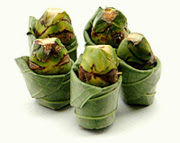The betel nut (also called as areca nut) is the seed of the betel palm, a kind of palm which grows in Asia, the tropical Pacific and East Africa, and contains mildly intoxicating and slightly addictive alkaloids. It is consumed in different ways from region to region.
For example, whereas in Vietnam a betel nut is ground and chewed along with betel pepper (the leaf of an Asian evergreen climbing plant, which is not botanically related to the betel palm) and lime (the white caustic alkaline substance, not the citrus fruit), in India it is crushed, mixed with tobacco and spices and chewed like a quid of tobacco.
In Taiwan, instead of being ground or crushed, the betel nut is usually consumed whole. There are three major preparations:
 jingzai (菁仔, 'the nut'): the most popular one, a whole raw betel nut cut half way through down the centre filled in with the inflorescence of betel pepper and red paste (made of lime and herbs and spices).
jingzai (菁仔, 'the nut'): the most popular one, a whole raw betel nut cut half way through down the centre filled in with the inflorescence of betel pepper and red paste (made of lime and herbs and spices). baoye (包葉, 'leaf-wrapped'): a whole nut wrapped in a betel pepper leaf pasted with lime.
baoye (包葉, 'leaf-wrapped'): a whole nut wrapped in a betel pepper leaf pasted with lime.- laoteng (老藤, 'old-stem'): similar to jingzai, but the stem of betel pepper is used rather than the inflorescence and white paste (only lime, without any spices) instead of red.
Certainly, I would never spit out the bloody saliva on the street and I know the bloody fact shown by tons of medical research that chewing betel nut could lead to oral cancer and other oral-related diseases, but I'm still desperate for a jingzai.





2 comments:
chheⁿ-á
I am in your position.
Post a Comment